There Is Good News If You Look Hard Enough
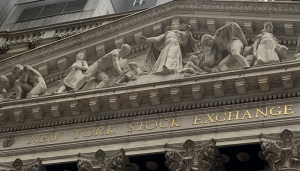
The headlines have been awful. The human toll from the virus continues to mount. The economic impact is jaw dropping. And we're told things are going to get worse this week.
Although stocks are bouncing in the early going Monday on the hope that the worst will soon be behind us, it is clear that stocks are in a bear market and that meaningful relief (I.E. Rallies that last more than a few days) can only come from good news on the virus front. Yes, the response by the Federal Reserve has been impressive. It's true that the CARES Act will provide relief to families and small businesses. And to be sure, a deal between the Saudis and Russians would be a near-term positive. But the bottom line is the longer the virus sticks around, the more damage is done.
Last week, I opined that one of the big problems here is there isn't an appropriate analog for investors to follow. The intentional shutdown of the economy simply hasn't happened before. As such, I believe the stock market is in the process of attempting to figure out/discount what comes next.
So, this morning, I'd like to try and take a look at this question.
Changing Consumer Behavior
I think we can all agree that the longer the economy remains closed, the more likely it is that consumer behavior will change going forward. It is said that if you do something for thirty days (think diet, exercise, or in this case, reduced spending) it can become a habit. The point is that such a change in consumer behavior is bad for the economy and argues against the idea that the economy will suddenly reopen and return to normal. I.E. There isn't likely to be an "it's all better now" moment.
How Do We Get A "V" Here?
I've spent a great deal of time on the phone lately with colleagues and friends in the business. Most of us have a lot of gray hair and have seen our share of crises and/or bear markets. My challenge to each has been the same, "Sell me on how we get a V-bottom here - for either the economy or the stock market."
It will suffice to say that the responses have been few. Well, except for, "the virus suddenly goes away" and "a drug/therapy solution is found," of course.
Good News On the Virus Front Coming?
On the latter, I read some promising news on drug therapies over the weekend. Here's a great piece from Dr. Scott Gottlieb in the WSJ that talks about two approaches that show serious promise. However, Dr. Gottlieb also warns that this is going to take a while.
"Some imagine that the coronavirus will run its tragic course in the spring, with the direst results avoided by intense social-distancing and other mitigation efforts, and then our lives can more or less return to normal in the summer," Dr. Gottlieb writes.
"But that isn't realistic," Gottlieb says. "Even if new cases start to stall in the summer heat, the virus will return in the fall, and so will fresh risk of large outbreaks and even a new epidemic. People will still be reluctant to crowd into stores, restaurants or arenas. Schools may remain closed. The public's fears won't relent simply because there are fewer new cases."
So, while I, like most folks, I presume, would love to think that will be able to go back to our lives like nothing has changed in the next month or so, it isn't likely to happen.
Looking At "The New Normal"
From a stock market perspective, this means that there will be a "new normal" do deal with/discount. So, let's think about that. As of Friday's close, the stock market is off between -26.5% and -38.29%, depending on which index you are looking at (the former is the decline in the S&P 500 while the latter is the drop in the Russell 2000 Smallcap Index). Surely this discounts a fair amount of bad news. But the key question is, how much is enough?
Over the weekend, I saw reports that 29% of the economy has been taken offline due to forty-one states issuing shelter-in-place orders. So, using a completely unscientific approach, one could argue that a stock price decline of ~30% might be about right.
However, this is most definitely not the way Mr. Market's game is played. No, there is a market multiple that gets applied to earnings which determines what is "about right" for each environment. Sometimes, a multiplier of 18-20 (or higher) is fine. At others, 12-14 might be more appropriate. Each is based on investors' collective expectations of the future and how much they are willing to pay for each dollar of earnings.
The Bad News: Getting To "Enough" Can Be Painful
While we don't have a good analog to follow for this particular crisis, we can look back at history and determine what the average decline during bear markets looks like. The goal of this exercise is to get a feel for how much might be enough.
According to Ned Davis Research, the stock market entered a bear phase on 2/12/20. At the low (which occurred on 3/23/20), the Dow had declined -37.1% in just 40 calendar days. For the record, NDR defines a bear market as follows: "A cyclical bear market requires a 30% drop in the DJIA after 50 calendar days or a 13% decline after 145 calendar days. Reversals of 30% in the Value Line Geometric Index also qualify." In this case, it was the dive in the Value Line Index that qualified the current dance to the downside as a bear market.
NDR's computers tell us that since September 1900, there have been 36 cyclical bear markets. The average decline for the DJIA has been -35.6% over a period of 399 calendar days. So, the decline of -37.1% is in the ballpark but the duration of 40 calendar days is super short relative to the historical mean.
We can then look at bear markets that occur during secular bull and bear cycles. Here's NDR's definition of a secular cycle: "A secular bull market is a period in which stock prices rise at an above-average rate for an extended period and suffer only relatively short intervening declines. A secular bear market is an extended period of flat or declining stock prices. Secular bull or bear markets typically consist of multiple cyclical bull and bear markets."
During cyclical bears that occur within secular bull cycles, the average decline has been -21.8%. Whereas the average bear that occurs during secular bear cycles is -36.3%. Ouch.
Next, since lots of folks believe the U.S. entered a recession in March, we can also look at what happens during bear markets that are accompanied by a recession. NDR's Ed Clissold reports that the average decline for bear markets that are accompanied by a recession is more along the lines of the declines during secular bear cycles - or about -36%.
So again, the Dow's most recent drop of -37.1% to the 3/23 low would seem to be a fairly average "discounting" of the bad economic news that is to come. But lest we forget, the damage associated with the last two recessions was far worse.
And in a Barron's report, David Rosenberg points out that since WWII, bear markets have "taken back" an average of 71% of the prior bull market's gains (and a median of 54%). According to Mr. Rosenberg, if history were to repeat here, the S&P 500 could decline to either 1455 or 1798 (or a drop of between 28% and 45% from Friday's close), depending on whether your statistical preference falls to the means or medians. That's not good news.
Now For The Good News
However, a look back at history provides us with some good news as well. And as a card-carrying member of the-glass-is-at-least-half-full club, I feel compelled to close this week's missive on an upbeat note.
You see, Ned Davis Research went back and looked at what happens to the stock market after a bad quarter occurs. In this case, they defined a "bad quarter" as a drop of 15% or more. And since the S&P dove by a nice, round 20% in the first quarter of 2020, the most recent quarter certainly qualifies.
Cutting to the chase, since WWII, after a quarter where the S&P drops by 15% or more, the index tends to enjoy gains that are more than double the historical norms for the ensuing one, two, three, four, and eight quarters.
For example, one quarter after a quarterly decline of 15% or more, the average gain has been +4.3% versus the average return for all quarters of +2.0%. And 85.7% of the ensuing quarters were positive.
Two quarters after the bad quarter, the average gain was +13.0% versus +4.2% and 100% of the two-quarter periods were positive. A similar story is seen three and four quarters later: +22.5% vs. +6.4% and +22.1% vs +8.7%, with the market rising 100% of the time.
And finally, two years after a big, bad quarterly decline, the average return for the S&P 500 since WWII has been +40.7% versus an average for all two-year periods of +18.0%. Oh, and the market was higher two years later 100% of the time. Yay!
So, is there a chance this time will be different? Absolutely. Again, I'm of the mind that the market can't look on the bright side again until there is good news on the virus front. And when that occurs is anybody's guess.
However, I think it is REALLY important to recognize that there will be upside ahead - as in significant upside ahead - once we get this virus under control. Oh, and I'd be willing to bet dollars to donuts that we will get it under control in the coming months.
In closing, let me add that for those of us with a propensity to look on the bright side, we can take solace in the idea that better days as well as opportunities for investing profits, lie ahead. And keeping this in mind as the news on the virus and the economy becomes downright discouraging might help.
Weekly Market Model Review
Each week we do a disciplined, deep dive into our key market indicators and models. The overall goal of this exercise is to (a) remove emotion from the investment process, (b) stay "in tune" with the primary market cycles, and (c) remain cognizant of the risk/reward environment.
The Major Market Models
We start with six of our favorite long-term market models. These models are designed to help determine the "state" of the overall market.
The biggest takeaway from Primary Cycle board is three are now three sell signals, two holds, and only one buy signal. And the lone buy signal may deserve a "yea, but" since neither the earnings nor the economic model are designed for the type of "full stop" situation the economy is experiencing now. Thus, my favorite models designed to help identify the "primary cycle" in the stock market remains negative.
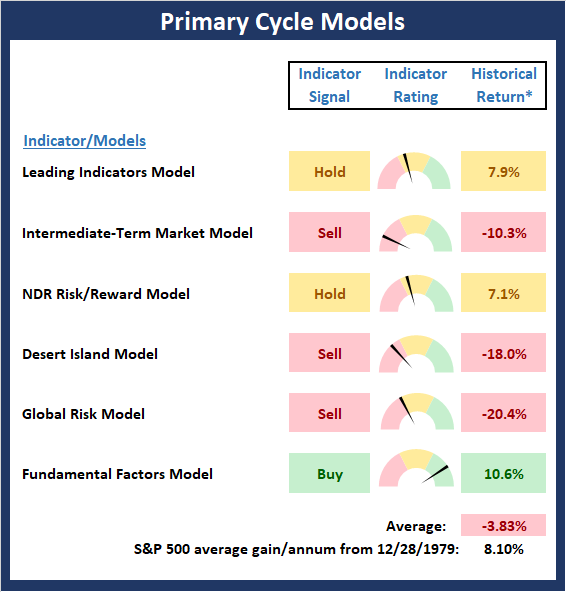
* Source: Ned Davis Research (NDR) as of the date of publication. Historical returns are hypothetical average annual performances calculated by NDR. Past performances do not guarantee future results or profitability - NOT INDIVIDUAL INVESTMENT ADVICE.
View My Favorite Market Models Online
The State of the Fundamental Backdrop
Next, we review the market's fundamental factors in the areas of interest rates, the economy, inflation, and valuations.
There are two changes to report on the Fundamental Factors board this week. First, the Economic Composite has shifted from positive to neutral. However, it is safe to say that this model is woefully behind the rapidly deteriorating economic curve at this point. In addition, the Valuation Composite moved into the positive zone from neutral. This tells me that there is likely to be meaningful upside when this market makes the turn and moves into a new bull cycle. But for now, the question is how much the E will fall in the P/E ratios.
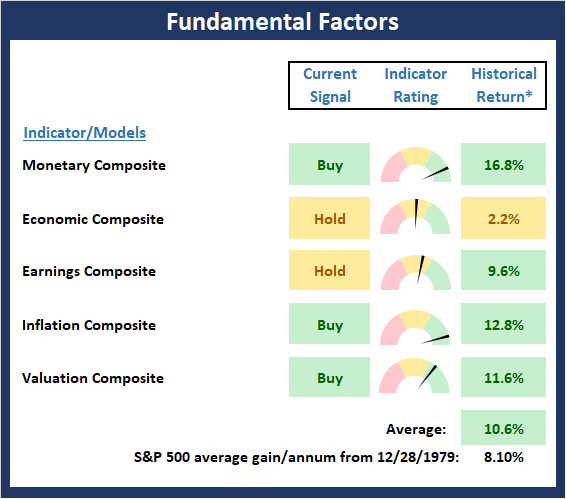
* Source: Ned Davis Research (NDR) as of the date of publication. Historical returns are hypothetical average annual performances calculated by NDR. Past performances do not guarantee future results or profitability - NOT INDIVIDUAL INVESTMENT ADVICE.
View Fundamental Indicator Board Online
The State of the Trend
After looking at the big-picture models and the fundamental backdrop, I like to look at the state of the trend. This board of indicators is designed to tell us about the overall technical health of the current trend.
Now that the initial bounce appears to have run its course, the Trend board has slipped back into the red. Note that I've broken the Trading Environment into two components - a short- and an intermediate-term view. From a short-term perspective, our indicators suggest that stocks are now in a mean reverting mode while from an intermediate-term view, the market is still in a trending lower mode. This suggests that a bottoming phase "could" be starting and that any "test" of the low will be important.
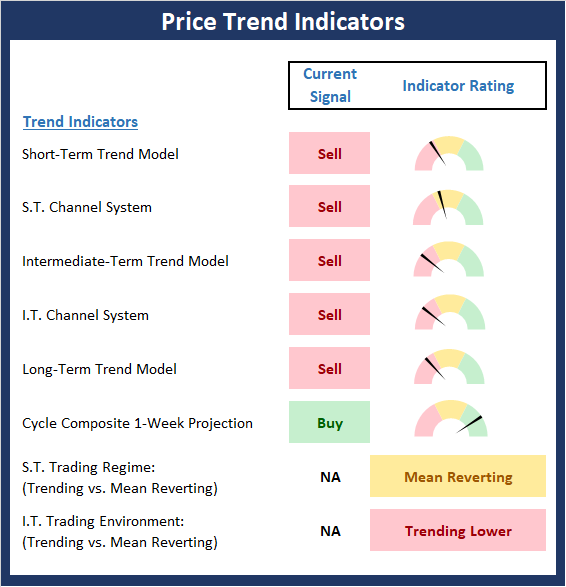
NOT INDIVIDUAL INVESTMENT ADVICE.
View Trend Indicator Board Online
The State of Internal Momentum
Next, we analyze the "oomph" behind the current trend via our group of market momentum indicators/models.
The Momentum Board remains a good "tell" for the current state of the market. In short, there isn't much good going on at the present time. I will also note that both the I.T. Volume and Breadth indicators are based on the NASDAQ index, which has been the best of the major indices in this cycle. AS such, even the modestly positive indicators need a caveat.
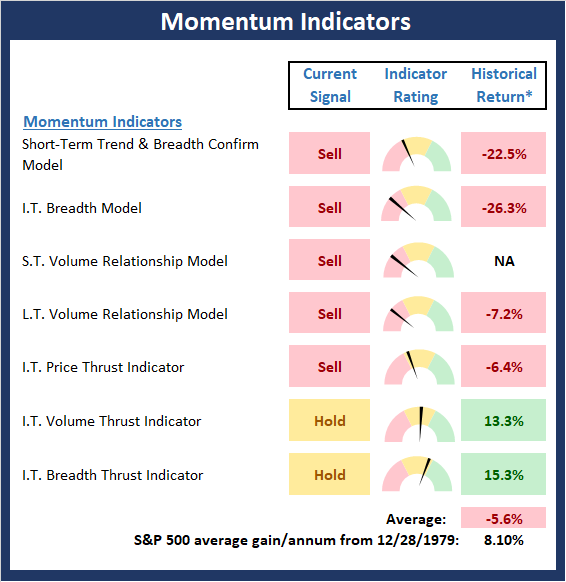
* Source: Ned Davis Research (NDR) as of the date of publication. Historical returns are hypothetical average annual performances calculated by NDR. Past performances do not guarantee future results or profitability - NOT INDIVIDUAL INVESTMENT ADVICE.
View Momentum Indicator Board Online
Early Warning Signals
Once we have identified the current environment, the state of the trend, and the degree of momentum behind the move, we then review the potential for a counter-trend move to begin. This batch of indicators is designed to suggest when the table is set for the trend to "go the other way."
The Early Warning board did a decent job alerting us to the likelihood of the traditional "dead cat bounce." And now that the bounce has occurred, the tailwinds from the extreme oversold condition that existed have waned. So, from a short-term perspective, neither team has much of an edge. However, with sentiment readings remaining largely negative (which is positive from a contrarian perspective) the edge remains with the bulls from an intermediate- and longer-term view. Yet, it is important to keep in mind that the bears remain in control of the game at this stage and will likely continue to do so until some good news on the virus front materializes.
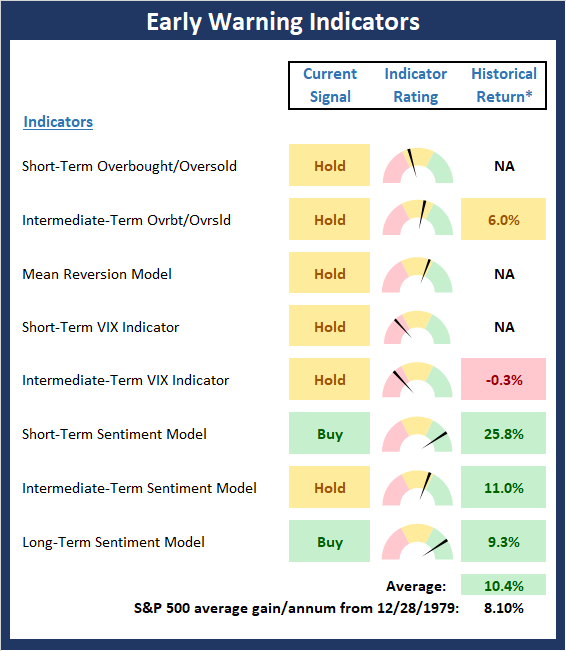
* Source: Ned Davis Research (NDR) as of the date of publication. Historical returns are hypothetical average annual performances calculated by NDR. Past performances do not guarantee future results or profitability - NOT INDIVIDUAL INVESTMENT ADVICE.
View Early Warning Indicator Board Online
Thought For The Day:
These are the times that try men's souls. The summer soldier and the sunshine patriot will, in this crisis, shrink from the service of their country; but he that stands by it now, deserves the love and thanks of man and woman. -Thomas Paine
Wishing you green screens and all the best for a great day,

David D. Moenning
Founder, Chief Investment Officer
Heritage Capital Research
Disclosures
At the time of publication, Mr. Moenning held long positions in the following securities mentioned: None - Note that positions may change at any time.
Leading Indicators Model: A group of indicators that have historically shown tendencies to lead the market at major turning points.
Intermediate-Term Market Model: A composite model (model of models) focused on trend and momentum indicators which has been designed to provide identify intermediate-term trading opportunities.
Risk/Reward Model: A model-of-models intended to provide an overall view of the state of the risk/reward environment. The model includes tape, monetary, and sentiment indicators as well as 7 big-picture market model readings.
Desert Island Model: If I was stranded on a desert island with access to only one market model to manage money with, this would be the model. The model is a comprehensive model-of-models comprised of trend, momentum, mean reversion, economic, monetary, sentiment, and factor-based indicators/models.
External Factors Model: A model-of-models designed to provide a reading on the "macro state" of the market environment. The model is comprised of indicators/models in the areas of various index yields, industrial production, investors sentiment, and historic volatility.
Short-Term Trend-and-Breadth Signal Explained: History shows the most reliable market moves tend to occur when the breadth indices are in gear with the major market averages. When the breadth measures diverge, investors should take note that a trend reversal may be at hand. This indicator incorporates NDR's All-Cap Dollar Weighted Equity Series and A/D Line. From 1998, when the A/D line is above its 5-day smoothing and the All-Cap Equal Weighted Equity Series is above its 25-day smoothing, the equity index has gained at a rate of +32.5% per year. When one of the indicators is above its smoothing, the equity index has gained at a rate of +13.3% per year. And when both are below, the equity index has lost +23.6% per year.
Channel Breakout System Explained: The short-term and intermediate-term Channel Breakout Systems are modified versions of the Donchian Channel indicator. According to Wikipedia, "The Donchian channel is an indicator used in market trading developed by Richard Donchian. It is formed by taking the highest high and the lowest low of the last n periods. The area between the high and the low is the channel for the period chosen."
Intermediate-Term Trend-and-Breadth Signal Explained: This indicator incorporates NDR's All-Cap Dollar Weighted Equity Series and A/D Line. From 1998, when the A/D line is above its 45-day smoothing and the All-Cap Equal Weighted Equity Series is above its 45-day smoothing, the equity index has gained at a rate of +17.6% per year. When one of the indicators is above its smoothing, the equity index has gained at a rate of +6.5% per year. And when both are below, the equity index has lost -1.3% per year.
Cycle Composite Projections: The cycle composite combines the 1-year Seasonal, 4-year Presidential, and 10-year Decennial cycles. The indicator reading shown uses the cycle projection for the upcoming week.
Trading Mode Indicator: This indicator attempts to identify whether the current trading environment is "trending" or "mean reverting." The indicator takes the composite reading of the Efficiency Ratio, the Average Correlation Coefficient, and Trend Strength models.
Volume Relationship Models: These models review the relationship between "supply" and "demand" volume over the short- and intermediate-term time frames.
Price Thrust Model Explained: This indicator measures the 3-day rate of change of the Value Line Composite relative to the standard deviation of the 30-day average. When the Value Line's 3-day rate of change have moved above 0.5 standard deviation of the 30-day average ROC, a "thrust" occurs and since 2000, the Value Line Composite has gained ground at a rate of +20.6% per year. When the indicator is below 0.5 standard deviation of the 30-day, the Value Line has lost ground at a rate of -10.0% per year. And when neutral, the Value Line has gained at a rate of +5.9% per year.
Volume Thrust Model Explained: This indicator uses NASDAQ volume data to indicate bullish and bearish conditions for the NASDAQ Composite Index. The indicator plots the ratio of the 10-day total of NASDAQ daily advancing volume (i.e., the total volume traded in stocks which rose in price each day) to the 10-day total of daily declining volume (volume traded in stocks which fell each day). This ratio indicates when advancing stocks are attracting the majority of the volume (readings above 1.0) and when declining stocks are seeing the heaviest trading (readings below 1.0). This indicator thus supports the case that a rising market supported by heavier volume in the advancing issues tends to be the most bullish condition, while a declining market with downside volume dominating confirms bearish conditions. When in a positive mode, the NASDAQ Composite has gained at a rate of +38.3% per year, When neutral, the NASDAQ has gained at a rate of +13.3% per year. And when negative, the NASDAQ has lost at a rate of -14.279% per year.
Breadth Thrust Model Explained: This indicator uses the number of NASDAQ-listed stocks advancing and declining to indicate bullish or bearish breadth conditions for the NASDAQ Composite. The indicator plots the ratio of the 10-day total of the number of stocks rising on the NASDAQ each day to the 10-day total of the number of stocks declining each day. Using 10-day totals smooths the random daily fluctuations and gives indications on an intermediate-term basis. As expected, the NASDAQ Composite performs much better when the 10-day A/D ratio is high (strong breadth) and worse when the indicator is in its lower mode (weak breadth). The most bullish conditions for the NASDAQ when the 10-day A/D indicator is not only high, but has recently posted an extreme high reading and thus indicated a thrust of upside momentum. Bearish conditions are confirmed when the indicator is low and has recently signaled a downside breadth thrust. In positive mode, the NASDAQ has gained at a rate of +22.1% per year since 1981. In a neutral mode, the NASDAQ has gained at a rate of +14.5% per year. And when in a negative mode, the NASDAQ has lost at a rate of -6.4% per year.
Short-Term Overbought/sold Indicator: This indicator is the current reading of the 14,1,3 stochastic oscillator. When the oscillator is above 80 and the %K is above the %D, the indicator gives an overbought reading. Conversely, when the oscillator is below 20 and %K is below its %D, the indicator is oversold.
Intermediate-Term Overbought/sold Indicator: This indicator is a 40-day RSI reading. When above 57.5, the indicator is considered overbought and wnen below 45 it is oversold.
Mean Reversion Model: This is a diffusion model consisting of five indicators that can produce buy and sell signals based on overbought/sold conditions.
VIX Indicator: This indicators looks at the current reading of the VIX relative to standard deviation bands. When the indicator reaches an extreme reading in either direction, it is an indication that a market trend could reverse in the near-term.
Short-Term Sentiment Indicator: This is a model-of-models composed of 18 independent sentiment indicators designed to indicate when market sentiment has reached an extreme from a short-term perspective. Historical analysis indicates that the stock market's best gains come after an environment has become extremely negative from a sentiment standpoint. Conversely, when sentiment becomes extremely positive, market returns have been subpar.
Intermediate-Term Sentiment Indicator: This is a model-of-models composed of 7 independent sentiment indicators designed to indicate when market sentiment has reached an extreme from a intermediate-term perspective. Historical analysis indicates that the stock market's best gains come after an environment has become extremely negative from a sentiment standpoint. Conversely, when sentiment becomes extremely positive, market returns have been subpar.
Long-Term Sentiment Indicator: This is a model-of-models composed of 6 independent sentiment indicators designed to indicate when market sentiment has reached an extreme from a long-term perspective. Historical analysis indicates that the stock market's best gains come after an environment has become extremely negative from a sentiment standpoint. Conversely, when sentiment becomes extremely positive, market returns have been subpar.
Absolute Monetary Model Explained: The popular cliche, "Don't fight the Fed" is really a testament to the profound impact that interest rates and Fed policy have on the market. It is a proven fact that monetary conditions are one of the most powerful influences on the direction of stock prices. The Absolute Monetary Model looks at the current level of interest rates relative to historical levels and Fed policy.
Relative Monetary Model Explained: The "relative" monetary model looks at monetary indicators relative to recent levels as well as rates of change and Fed Policy.
Economic Model Explained: During the middle of bull and bear markets, understanding the overall health of the economy and how it impacts the stock market is one of the few truly logical aspects of the stock market. When our Economic model sports a "positive" reading, history (beginning in 1965) shows that stocks enjoy returns in excess of 21% per year. Yet, when the model's reading falls into the "negative" zone, the S&P has lost nearly -25% per year. However, it is vital to understand that there are times when good economic news is actually bad for stocks and vice versa. Thus, the Economic model can help investors stay in tune with where we are in the overall economic cycle.
Inflation Model Explained: They say that "the tape tells all." However, one of the best "big picture" indicators of what the market is expected to do next is inflation. Simply put, since 1962, when the model indicates that inflationary pressures are strong, stocks have lost ground. Yet, when inflationary pressures are low, the S&P 500 has gained ground at a rate in excess of 13%. The bottom line is inflation is one of the primary drivers of stock market returns.
Valuation Model Explained: If you want to get analysts really riled up, you need only to begin a discussion of market valuation. While the question of whether stocks are overvalued or undervalued appears to be a simple one, the subject is actually extremely complex. To simplify the subject dramatically, investors must first determine if they should focus on relative valuation (which include the current level of interest rates) or absolute valuation measures (the more traditional readings of Price/Earnings, Price/Dividend, and Price/Book Value). We believe that it is important to recognize that environments change. And as such, the market's focus and corresponding view of valuations are likely to change as well. Thus, we depend on our Valuation Models to help us keep our eye on the ball.
Disclosures
NOT INVESTMENT ADVICE. The opinions and forecasts expressed herein are those of Mr. David Moenning and Heritage Capital Research and may not actually come to pass. The opinions and viewpoints regarding the future of the markets should not be construed as recommendations. The analysis and information in this report is for informational purposes only. No part of the material presented in this report is intended as an investment recommendation or investment advice. Neither the information nor any opinion expressed constitutes a solicitation to purchase or sell securities or any investment program.
Any investment decisions must in all cases be made by the reader or by his or her investment adviser. Do NOT ever purchase any security without doing sufficient research. There is no guarantee that the investment objectives outlined will actually come to pass. All opinions expressed herein are subject to change without notice. Neither the editor, employees, nor any of their affiliates shall have any liability for any loss sustained by anyone who has relied on the information provided.
Mr. Moenning of Heritage Capital Research is an investment adviser representative of Eastsound Capital Advisors, LLC, a registered investment advisor. The adviser may not transact business in states where it is not appropriately registered, excluded or exempted from registration. Individualized responses to persons that involve either the effecting of transaction in securities, or the rendering of personalized investment advice for compensation, will not be made without registration or exemption.
Mr. Moenning and Heritage Capital Research may at times have positions in the securities referred to and may make purchases or sales of these securities while publications are in circulation. Positions may change at any time.
The analysis provided is based on both technical and fundamental research and is provided "as is" without warranty of any kind, either expressed or implied. Although the information contained is derived from sources which are believed to be reliable, they cannot be guaranteed.
The author neither endorses nor warrants the content of this site, any embedded advertisement, or any linked resource. The author or his managed funds may hold either long or short positions in the referenced securities. Republication rights must be expressly granted by author in writing.
Investments in equities carry an inherent element of risk including the potential for significant loss of principal. Past performance is not an indication of future results.

